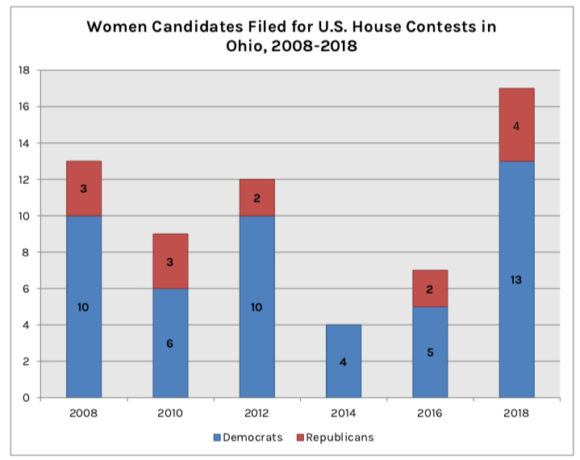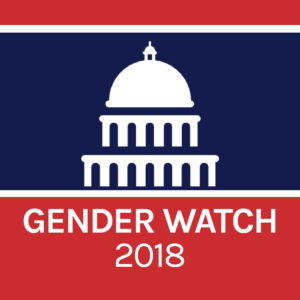Ahead of the Ohio primary election on May 8, 2018, we outline the numbers and proportions of women who have filed as candidates for congressional and statewide office. The data below also provide points of historical comparison to give context to today’s presence and potential success of women candidates.
All data are provided from the Center for American Women and Politics, Eagleton Institute of Politics, Rutgers University. For a full list of the women candidates in IL primary races for congressional and statewide offices, see CAWP’s Election Watch page.
CONGRESS
Current: 3 (3D) of 18 members of the OH congressional delegation (16.7%)
Filed: 18 (13D, 5R)*
Percent of all Filed Congressional Candidates (D/R): 19.8% (18 of 91)
SENATE
Current: 0 of 2 senators
- No woman has ever represented Indiana in the U.S. Senate.
Filed: 1 (1R)
- 1 (1R) woman has filed to run for the Republican nomination to challenge Democratic incumbent Senator Sherrod Brown. He is running unopposed in the primary.
HOUSE
Current: 3 (3D) of 16 representatives (18.8%)
- All 3 (3D) women House incumbents are running for re-election this year.
- A total of 11 (7D, 4R) women have represented OH in the U.S. House, including the three current women representatives from OH.
Filed: 17 (13D, 4R)*
- 8 (8D) women are running to challenge Republican incumbents in the general election and 1 Republican woman is running to challenge a Democratic incumbent in the general election.
- 5 (2D, 3R) women are running for the state’s 2 open House seat contests. In the 12th Congressional district, 3 (1D, 2R) women are running simultaneously to fill the vacant seat and for the general election nomination.
*Democrat Leah Sellers withdrew from the 4th district race after filing. However, she is included in these counts because she will appear on primary ballots.

Districts with Women Candidates: 11 of 16
Percent of all Filed House Candidates (D/R): 20.2% (17 of 84)
Percent of all Filed Democratic House Candidates: 29.5% (13 of 44)
Percent of all Filed Republican House Candidates: 10% (4 of 40)
Recent history: The number of women who filed for major party candidacy for the U.S. House in Ohio in 2018 is a record high. Between 2008 and 2018, the next highest number of women candidates filed to run for the U.S. House was 13 in 2008, when there were 4 open U.S. House seats being contested. This year, there are just 2 open House seats in Ohio.
- The highest number of Democratic women running for the U.S. House in Ohio between 2008 and 2016 was 10 in 2008 and 2012. This year, 13 Democratic women filed to run for House seats. The number of Republican women candidates (4) is also higher this year than any year in the past decade. Three Republican women candidates ran for the U.S. House in Ohio in 2008 and 2010.
GOVERNOR
Current: 0
Nancy Hollister (R) served as governor of Ohio for 11 days from 1998 to 1999, but no woman has been elected governor of Ohio.
Filed: 1 (1R)
Percent of all Filed Gubernatorial Candidates (D/R): 12.5% (1 of 8)
Percent of all Filed Democratic Gubernatorial Candidates: 0% (0 of 6)
Percent of all Filed Republican Gubernatorial Candidates: 50% (1 of 2)
Recent history: This year’s only woman candidate for governor – current Lieutenant Governor Mary Taylor (R) – is the only female major party candidate for governor in the past three gubernatorial elections.
OTHER STATEWIDE ELECTED EXECUTIVE OFFICES
Current: 1 (1R) of 6 positions (excludes governor) (16.7%)
- Republican incumbent Lieutenant Governor Mary Taylor is running for governor.
Filed: 6 (5D, 1R)
- 4 (4D) women are running for lieutenant governor of Ohio. They represent half of all running mates on this year’s major party gubernatorial tickets.
- 2 Black women are candidates for lieutenant governor: Tara Samples and Chantelle Lewis. The first Black woman to serve as lieutenant governor in Ohio was Jennette Bradley (R) from 2003 to 2005.
- 1 (1D) woman, Kathleen Clyde, is running for the open secretary of state position. She is unopposed for the Democratic nomination.
- 1 (1R) woman, Sandra O’Brien, is running for the open state treasurer position. She is one of two Republicans competing in the primary.
Percent of all Filed Statewide Executive (other than governor) Candidates (D/R): 35.3% (6 of 17)
Percent of all Filed Democratic Statewide Executive (other than governor) Candidates: 50% (5 of 10)
Percent of all Filed Republican Statewide Executive (other than governor) Candidates: 14.3% (1 of 7)
Recent history: The number of women who filed for major party candidacy for statewide elected executive offices (other than governor) in Ohio in 2018 is greater than the number who filed in 2014 (4: 3D, 1R) and 2010 (4: 2D, 2R), when the same set of offices were last contested.


 From March to December 2018, the
From March to December 2018, the 